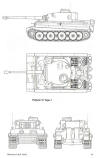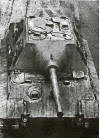|
|
Panzer PzKpfw Mk VI (Tiger I) |
|
Panzer Mk VI (Tiger I) History
Origins
Up till 1941 it was felt that the PzKpfw III and IV were
adequate for any tasks likely to be encountered, but this complacency had
already been ruffled in France in 1940 when it was discovered that many
French and British tanks, especially the British Matilda, were more
heavily armoured than their German counterparts.
The discovery of the considerable combat potential of the Russian T-34 and
KV-I in 1941 therefore showed the German designs to be at a disadvantage.
Hitler himself had envisaged the need for a new and heavier tank design in
May 1941 and the events in Russia seemed to confirm the accuracy of his
'intuition .
The result was a design specification for a heavy tank mounting a 8.8 cm
gun and having sufficient armour to defeat all the likely future anti-tank
weapons. Two firms, Porsche and Henschel, submitted designs for what was
given the design designation of VK 3601, and both firms built prototypes
mounting a large Krupp-designed turret. The Porsche design had many novel
features including a petrol-electric drive system, but it was not selected
for service
The chassis was, however, selected as a heavy tank-killer mobile gun
carrier, and eventually emerged as the Ferdinand or Elefant. In this form
it became one of the most monumental failures of the German armament
industry at the Battle of Kursk, for it was underdeveloped and lacked a
secondary defensive machine-gun.
But to return to the Henschel design — this was chosen for production and
was named the PzKpfw VI or Tiger. Production began slowly in August 1942
but soon increased in volume after the personal intervention of Hitler.
At the time of its introduction, the Tiger was the most powerful tank in
the world. It was armed with the formidable 8.8 cm KwK 36 which had been
developed from the 88 cm Flak 18 and 36 anti-aircraft gun. At its
thickest, the Tiger's armour was a hefty 102 mm and was thus almost
invulnerable to all anti-tank weapons then in use.
But its mam disadvantage was its bulk and weight. Its bulk was such that
it was too heavy for most European bridges and had to be fitted with
wading equipment and air schnorkels . It was too wide for most railway
flatcars and had to have two tracks — one for action and another narrower
set for railway transport, which also involved removing roadwheels and
side shields. Weight was 56 tons which severely restricted its battlefield
hand-
ling, but the Tiger was considered to be a formidable opponent and Allied
armies had to evolve special tactics to counter the Tiger. Production
ceased in August 1944 by which time 1,350 Tigers had been delivered.
Models
PzKpfw VI Tig«r Ausf E
Only one Tiger model, the Ausf E. was built but it was made in several
different versions. The first version had extensive wading equipment and
triple overlapping road wheels. These road wheels were arranged in three
rows and were suspended on torsion bars. The outer road wheels had to be
removed for railway transport and narrower tracks were then used which
involved a considerable expenditure of time and trouble. Another
unforeseen disadvantage of the interleaved road wheel system was
discovered in Russia when mud. slush and snow froze solid between the
wheels and immobilised the vehicles
Late variants used a much simplified road wheel system with steel
resilient wheels in place of the earlier solid dished wheels with their
rubber tyres. Other changes made included a more powerful engine increased
in size from 21 to 24 litres. Later versions also omitted the wading
equipment Tigers built for use in Africa had a special Tp designation
denoting suitable for tropical use which involved special air filters for
the engine. These filters were also found on Tigers used in Russia.
Other changes incorporated were to the commander's cupola and minor
changes to the drive mechanism, but the basic Tiger design remained
substantially unchanged to the end. It was the most powerful tank of its
day, but with the arrival of the Russian heavy tanks that day soon passed,
and the Tigers bulk and weight made it more of a mobile pill-box rather
than a fighting tank.
Variants
Panzerbefehlswagen Tiger Ausf E (SdKfz 267 and 268) Some Tigers were
converted to command tanks by the addition of extra radio equipment The
two SdKfz variants differed only in the types of radio fitted
Bergepanzer Tiger A small number of Tigers were converted to the armoured
recovery role by having their guns removed and replaced by a winch. The
exact number converted was very small and may even have been only one.
Sturmtiger Ten Tiger chassis were converted in 1944 for street fighting by
the addition of a large armoured superstructure mounting a 38 cm rocket
projector This weapon was originally intended as a naval antisubmarine
device and fired a hefty 345.5 kg (761 Ib) rocket intended for house
demolition. The conversion was not a success on account of the vehicle s
weight (70 tons) and awkward bulk. This variant consumed two gallons of
fuel for every mile travelled.
Technical Specification
Mk VI (Tiger I) Variations & Plans
|
Plans |
Mk VI with Zimmerit cover | Captured Mk VI Sturmtiger | Mark IV Elephant | |
 |
 |
 |
 |
No Image |
| Specifications | Ausf E | ||
| No Image |
No Image |
No Image |
|
| Weight | 56 Tons |
|
|
| Max Road Speed | 38 kph / 23.6 mph | ||
| Road range | 100 km / 62 miles | ||
| Cross Country Range | 60 km / 37 miles | ||
| Length Overall | 8,240 mm / 324.4 inches | ||
| Width | 3,730 mm / 146.5 inches | ||
| Height | 2,860 mm / 112.6 inches | ||
| Engine | 700 Horse Power | ||
| Track Width | 725 mm / 28.5 inches | ||
| Wheel base | 2,830 mm / 111.4 inches | ||
| Armament 1 | 1 8.8 cm KwK 36 | ||
| Armament 2 | 2 or 3 7.92 mm MG | ||
| Ammunition Carried 1 | 92 x 8.8 cm | ||
| Ammunition Carried 2 | 3,920 x .92 mm | ||
| Bow Armour | 100 mm / 3.93 inches | ||
| Side Armour | 80 mm / 3.15 inches | ||
| Roof & Floor Armour | 26 mm / 1.02 inches | ||
| Turret Armour | 100 mm / 3.93 inches | ||
| Crew | 5 |

